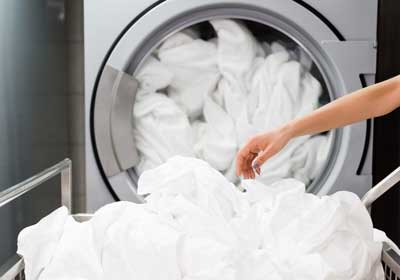Does Washing Bedding and Clothing in High Heat Kill Bed Bugs?
Yes! Washing and drying infested bedding in high heat is one of the most effective methods of DIY bed bug control and bed bug extermination in general.
Although it may not stop your entire infestation, it will alleviate the bed bug problem.
Here’s how to get rid of bed bugs with a high heat wash:
- Strip your bed of all sheets and gather any clothes you’re washing with them.
- Transport all infested items to the washing machine in sealable bags, preferably plastic.
- Wash all items at at least 140°F for over an hour and a half.
- Quickly move all washed sheets and clothes to the dryer. Dry everything at the highest heat setting for at least an hour.

Proper Cleaning for Bed Bugs in Wisconsin
So, what do you do once you find out you have bed bugs? One of the best ways to control your infestation is by washing any infested items in a high-heat wash. First, you have to sort your clothes. After sorting, place each pile into its own plastic bag. Seal these bags in order to safely transport them to the washing machine, preventing any potential spread.
What Type of Soap Should You Use to Kill Bed Bugs in the Washer?
It actually doesn’t matter at all. It’s not the soap that’s killing them – it’s the heat. That’s why you want to make sure you wash and dry on the highest possible heat setting. We recommend at least an hour, but you can keep them in longer than that.
Should You Use an Extra Rinse Cycle?
No, adding an extra rinse cycle won’t make the treatment more effective. Any additional time in the dryer will add a greater benefit.
Should You Use Eco Wash to Kill Bed Bugs in the Washing Machine?
No, and this is important. Eco wash and energy-saving wash cycles aren’t as hot as regular wash cycles. If you use this feature, it could undermine your efforts completely.
Don’t Overload the Washer or Dryer
One important thing to remember is to save some space in the washer and dryer so your clothes and linen have a chance to move around. This allows the heat to disperse evenly throughout, which makes it more effective at killing bed bugs.
Do You Have a Bed Bug Problem? We Can Help.
Click the button below to leave your information & we'll be in touch in an hour or less.
Leave your information below and we will give you a call back.
"*" indicates required fields
*During normal business hours. After hours inquiries will be returned the next business day.
Can Bed Bugs Live After A Cycle in the Washing Machine?
Yes, it is possible. Extreme temperatures, both hot and cold, are the most effective killers of bed bugs. But some can still survive.
Washing your bedding and clothing in hot water should kill off any bed bugs and bed bug eggs effectively. Make sure you are cautious when moving your infested items to the washing machine, though. Being haphazard could lead to the further spread of bed bugs!
How Should You Put Away Your Clothes and Bedding?
You can’t put it away normally, as it’s at risk for immediate reinfestation. Your goal is to prevent your now-sterile clothes from touching any surface in your home, which you must assume is contaminated.
- Get plastic bags ready: Do not use your old laundry basket — it’s contaminated. Before your dryer cycle ends, get a box of heavy-duty plastic bags. Place them near the dryer.
- Bag everything quickly: When the dryer stops, take the hot items out and put them directly into the plastic bags. Seal each bag tightly, squeezing out the air.
- Quarantine your bags: Store these sealed bags in a “safe zone,” like the middle of a room away from furniture or in a clean plastic storage bin. It may be helpful to label the bags (e.g., “shirts,” “socks,” “bedsheets”).
- Continue treatment for the root problem: This strict quarantine ends only when your home is bed bug-free. Only then is it safe to return your items to your closets and drawers.
Will Washing Bed Bug Infested Linens Work Every Time?
While washing and drying your clothes and bedding in hot temperatures is very effective, this method doesn’t help when it comes to certain areas of your home that may be infested. Getting rid of an entire infestation requires treatment that spans across the infested area.
